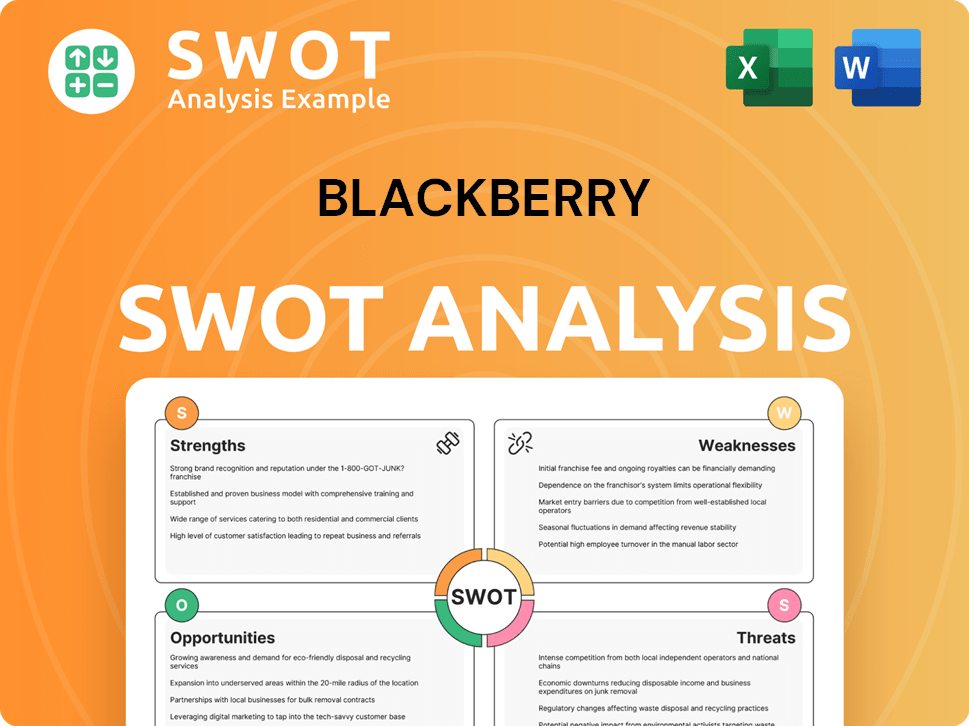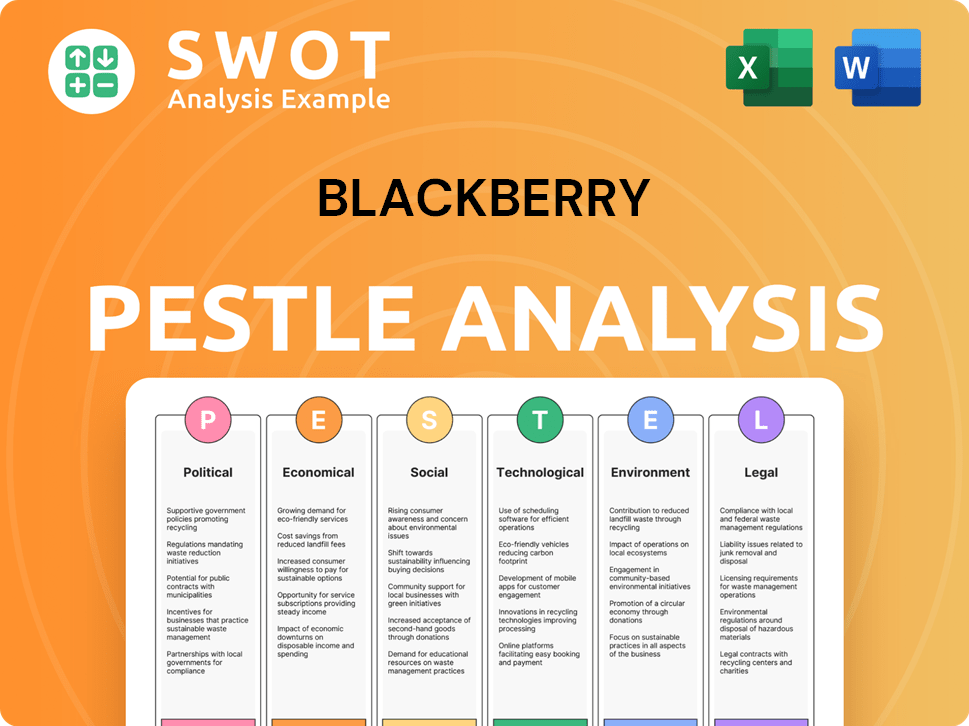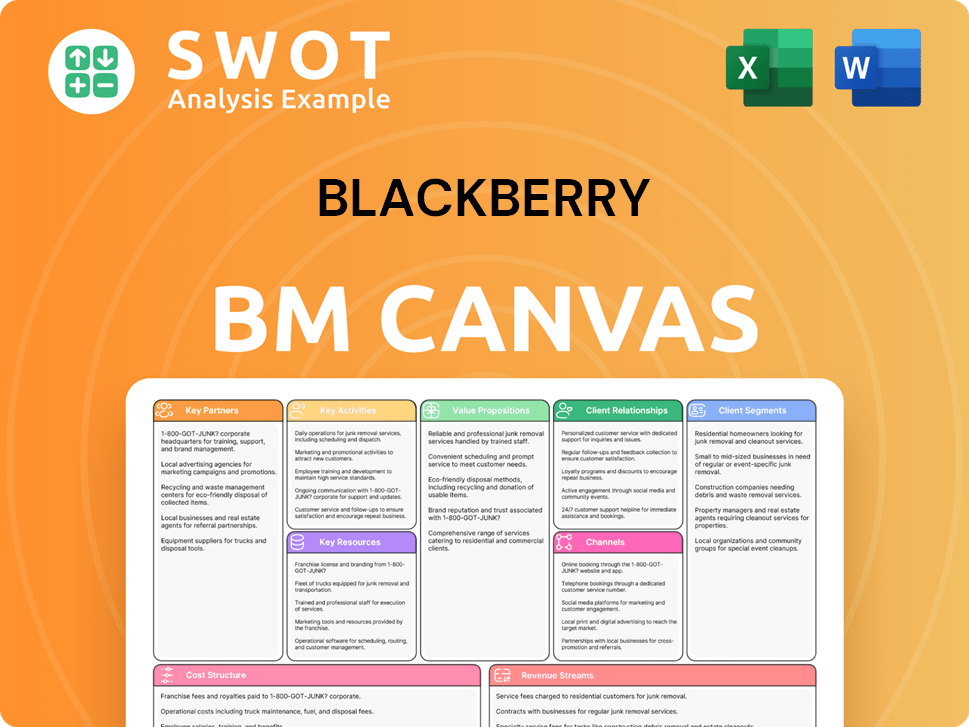BlackBerry Bundle
How Did BlackBerry Reinvent Its Sales and Marketing Strategy?
Once a titan of the mobile world, BlackBerry has undergone a remarkable transformation. This evolution involved a complete overhaul of its sales and marketing strategies, shifting from consumer devices to enterprise software solutions. Today, BlackBerry is a cybersecurity and IoT powerhouse, but how did it get here?

This strategic pivot, born from the company's need to adapt, has redefined its BlackBerry SWOT Analysis and market position. Understanding the evolution of BlackBerry's sales strategy and marketing strategy is crucial for anyone interested in business resilience and strategic adaptation. Examining its BlackBerry SWOT Analysis will help us understand how the company has navigated the competitive landscape, rebuilt its brand reputation, and targeted its enterprise customers, ultimately impacting its BlackBerry market share.
How Does BlackBerry Reach Its Customers?
The sales channels of the company have significantly transformed, now primarily targeting enterprise and government clients worldwide. This shift reflects a strategic pivot from a hardware-centric model to a software and services provider. The company's BlackBerry sales strategy now emphasizes direct engagement and strategic alliances to meet the complex needs of its target audience.
A direct sales force handles large enterprise and government contracts, providing tailored solutions and managing direct relationships. This approach is complemented by a network of channel partners, including value-added resellers (VARs), system integrators (SIs), and managed security service providers (MSSPs). These partners extend the company's reach across various industries and geographies, offering specialized implementation and support services. The evolution of these channels underscores the company's strategic shift towards a B2B focus.
While e-commerce platforms play a lesser role for complex enterprise solutions, the company's website serves as a crucial hub for information, lead generation, and partner program management. The company also engages in strategic alliances, such as its partnership with AWS for its IVY platform, which aims to accelerate the development of connected vehicle services. This partnership leverages AWS's cloud infrastructure to deliver the company's automotive software solutions, demonstrating a strategic shift towards integrated ecosystem sales.
The company utilizes a direct sales force to manage large enterprise and government contracts. This approach allows for tailored solutions and direct relationship management. This strategy is crucial for securing significant deals and ensuring customer satisfaction.
A robust network of channel partners, including VARs, SIs, and MSSPs, extends the company's reach. These partners offer specialized implementation and support services. This network is vital for expanding into various industries and geographies.
Strategic alliances, such as the partnership with AWS for the IVY platform, are key. These partnerships leverage external infrastructure to deliver automotive software solutions. This approach demonstrates a shift towards integrated ecosystem sales.
The company's website serves as a crucial hub for information, lead generation, and partner program management. While e-commerce plays a lesser role, the website supports complex enterprise solutions. This platform is essential for providing resources and managing partnerships.
The company's sales strategy is designed to reach enterprise customers effectively. This involves a direct sales approach, complemented by a strong channel partner network. Strategic alliances further enhance market penetration and solution delivery.
- Direct Engagement: The direct sales force focuses on building relationships with large enterprise and government clients.
- Partner Network: Channel partners provide specialized services and extend market reach.
- Strategic Alliances: Partnerships with companies like AWS enable integrated solutions and ecosystem sales.
- Website and E-commerce: The website supports information dissemination, lead generation, and partner program management.
BlackBerry SWOT Analysis
- Complete SWOT Breakdown
- Fully Customizable
- Editable in Excel & Word
- Professional Formatting
- Investor-Ready Format

What Marketing Tactics Does BlackBerry Use?
The marketing tactics employed by the company are primarily geared toward business-to-business (B2B) and business-to-government (B2G) clients. This strategy emphasizes thought leadership, technical expertise, and solutions-oriented content to attract and retain its target audience. Digital channels form the backbone of its marketing efforts, with a strong emphasis on content marketing and targeted advertising.
Digital marketing efforts include content marketing through whitepapers, case studies, webinars, and industry reports. Search Engine Optimization (SEO) is also critical for ensuring visibility when enterprises search for security and UEM (Unified Endpoint Management) solutions. Paid advertising is strategically deployed on platforms like LinkedIn and industry-specific publications to target IT decision-makers and cybersecurity professionals.
Email marketing campaigns are used for lead nurturing, product updates, and event invitations. The company also actively participates in and sponsors key industry events and conferences. BlackBerry leverages data-driven marketing to segment its target audience based on industry, company size, and specific security needs, allowing for personalized messaging and solution recommendations. This approach is vital for the company's Competitors Landscape of BlackBerry.
Content marketing is a cornerstone of the marketing strategy, with a focus on providing valuable information through whitepapers, case studies, and webinars. This approach establishes the company as a thought leader in cybersecurity, IoT, and automotive solutions. This strategy helps in building brand reputation.
SEO is essential for ensuring visibility when enterprises search for security and UEM solutions. The company also utilizes paid advertising on platforms like LinkedIn and industry-specific publications. These efforts are designed to reach IT decision-makers and cybersecurity professionals directly.
Paid advertising campaigns are strategically deployed on platforms such as LinkedIn and industry-specific publications. These campaigns target IT decision-makers and cybersecurity professionals. This approach is crucial for lead generation and brand awareness.
Email marketing is used for lead nurturing, product updates, and event invitations. The company actively participates in and sponsors key industry events and conferences. This strategy supports customer relationship management.
The company leverages data-driven marketing to segment its target audience based on industry, company size, and specific security needs. This allows for personalized messaging and solution recommendations. This approach helps in analyzing BlackBerry's target audience.
The company highlights its secure software solutions for the automotive industry, emphasizing its QNX technology's role in over 275 million vehicles. This focus on specific use cases and demonstrable impact is a core element of its marketing strategy. This helps in understanding BlackBerry's product portfolio.
The company's marketing efforts are concentrated on digital channels, content marketing, and targeted advertising. These strategies are designed to reach the B2B and B2G markets effectively. The focus is on demonstrating technological prowess in niche, high-value markets.
- Content Marketing: Whitepapers, case studies, webinars, and industry reports.
- SEO: Ensuring visibility for security and UEM solutions.
- Paid Advertising: LinkedIn and industry-specific publications.
- Email Marketing: Lead nurturing, product updates, and event invitations.
- Industry Events: Participation and sponsorship for direct engagement.
- Data-Driven Marketing: Personalized messaging and solution recommendations based on audience segmentation.
BlackBerry PESTLE Analysis
- Covers All 6 PESTLE Categories
- No Research Needed – Save Hours of Work
- Built by Experts, Trusted by Consultants
- Instant Download, Ready to Use
- 100% Editable, Fully Customizable

How Is BlackBerry Positioned in the Market?
BlackBerry's brand positioning has undergone a significant transformation, shifting from a consumer-focused smartphone provider to a specialized vendor of cybersecurity software and services. The core message centers around 'Intelligent Security. Everywhere.™,' highlighting its dedication to securing endpoints and enabling secure communication across various industries. This evolution is crucial for understanding the current BlackBerry sales strategy and BlackBerry marketing strategy.
The company now targets IT professionals, cybersecurity experts, and government agencies, leveraging its established reputation in mission-critical environments. BlackBerry differentiates itself through its rich security heritage, its robust QNX operating system for embedded systems, and its comprehensive suite of cybersecurity solutions, including Cylance AI-driven threat detection. This strategic shift is vital for maintaining and improving BlackBerry market share in a competitive landscape.
BlackBerry's brand identity is now professional, authoritative, and focused on trust and reliability, reflecting the critical nature of cybersecurity. The company positions itself as a premium provider of highly secure and reliable solutions, justifying its value proposition through reduced risk and operational efficiency. This approach is essential for understanding the BlackBerry business model and how it generates revenue.
BlackBerry has transitioned from a consumer-focused brand to a B2B cybersecurity provider. Its messaging now emphasizes 'Intelligent Security. Everywhere.™,' focusing on securing endpoints and enabling secure communication. This shift reflects a strategic adaptation to changes in the market and competitive pressures.
The primary target audience includes IT professionals, cybersecurity experts, and government agencies. BlackBerry leverages its proven track record in mission-critical environments to build trust and credibility. This targeted approach is crucial for effective marketing and sales efforts.
Key differentiators include a strong heritage in security, the QNX operating system for embedded systems, and a comprehensive suite of cybersecurity solutions. The company's focus on innovation, particularly in areas like endpoint security and UEM, sets it apart. This differentiation supports its premium positioning.
Brand consistency is maintained across its website, marketing materials, and industry events. This consistency reinforces its image as a trusted security partner. The consistent messaging and branding are essential for building and maintaining a strong brand reputation.
BlackBerry’s strategic shift is evident in its commitment to providing comprehensive cybersecurity solutions. The company's QNX software is a significant component in the automotive industry, with approximately 275 million cars containing its technology, demonstrating a strong brand position in the embedded systems market. To learn more about the company's financial performance and how it generates revenue, consider exploring the Revenue Streams & Business Model of BlackBerry.
BlackBerry Business Model Canvas
- Complete 9-Block Business Model Canvas
- Effortlessly Communicate Your Business Strategy
- Investor-Ready BMC Format
- 100% Editable and Customizable
- Clear and Structured Layout

What Are BlackBerry’s Most Notable Campaigns?
The shift in focus for the company has led to campaigns centered on showcasing its expertise in cybersecurity and the Internet of Things (IoT), moving away from consumer product launches. These campaigns are designed to highlight the company's strengths in the B2B and B2G sectors. The objective is to reposition itself as a key player in these rapidly evolving technology areas. The Growth Strategy of BlackBerry has been significantly impacted by these changes.
One major ongoing campaign revolves around its 'Cylance AI' capabilities, emphasizing its predictive threat prevention technology. This involves various digital content formats, including whitepapers, webinars, and case studies. These resources are distributed through industry publications and targeted online advertising to establish the company as a leader in AI-driven cybersecurity. Another key initiative is the promotion of BlackBerry QNX within the automotive industry, highlighting its role in advanced driver-assistance systems (ADAS) and autonomous driving.
These campaigns leverage partnerships and industry events to reinforce its position. The creative concept focuses on the reliability and security of QNX, which is crucial for automotive original equipment manufacturers (OEMs). The company’s approach reflects a strategic adaptation to the changing technology landscape, capitalizing on its core competencies in secure software and services.
This campaign focuses on highlighting the company's AI-driven cybersecurity solutions. It uses digital content like whitepapers and webinars. The goal is to position the company as a leader in AI-driven cybersecurity.
This initiative promotes QNX in the automotive sector. It emphasizes QNX's role in ADAS and autonomous driving systems. The focus is on reliability and security, crucial for automotive OEMs.
The company publishes the 'BlackBerry Cyber Security Report' annually. These reports serve as valuable lead generation tools. They help establish the company's authority and insights in the cybersecurity field.
The company's continuous efforts to educate the market about its software transformation. This serves as a rebranding campaign, moving perception beyond its legacy hardware. It aims to highlight the shift to software and services.
The success of these campaigns is reflected in the sustained growth of the IoT and Cybersecurity segments. The company reported revenues of $205 million for IoT and $299 million for Cybersecurity in fiscal year 2024. These figures indicate the effectiveness of the targeted marketing efforts.
The company actively collaborates with automotive manufacturers and participates in industry trade shows. These partnerships and event participations are crucial for the promotion of QNX in the automotive sector. This strategy enhances brand visibility.
The company focuses on educating the market about its software transformation. This involves continuous efforts to communicate the shift from hardware to software and services. The aim is to change market perception.
Thought leadership campaigns, such as the 'BlackBerry Cyber Security Report,' are key. These reports are widely distributed and serve as valuable tools for generating leads. They help establish the company’s authority in the market.
The company enhances brand visibility through collaborations with industry analysts. Participation in cybersecurity forums further boosts its credibility. This strategy strengthens its position in the B2B and B2G sectors.
The marketing efforts are highly targeted, focusing on specific industry segments. The campaigns are tailored to highlight its cybersecurity and IoT expertise. This approach ensures that the marketing aligns with the company's strategic goals.
BlackBerry Porter's Five Forces Analysis
- Covers All 5 Competitive Forces in Detail
- Structured for Consultants, Students, and Founders
- 100% Editable in Microsoft Word & Excel
- Instant Digital Download – Use Immediately
- Compatible with Mac & PC – Fully Unlocked

Related Blogs
- What are Mission Vision & Core Values of BlackBerry Company?
- What is Competitive Landscape of BlackBerry Company?
- What is Growth Strategy and Future Prospects of BlackBerry Company?
- How Does BlackBerry Company Work?
- What is Brief History of BlackBerry Company?
- Who Owns BlackBerry Company?
- What is Customer Demographics and Target Market of BlackBerry Company?
Disclaimer
All information, articles, and product details provided on this website are for general informational and educational purposes only. We do not claim any ownership over, nor do we intend to infringe upon, any trademarks, copyrights, logos, brand names, or other intellectual property mentioned or depicted on this site. Such intellectual property remains the property of its respective owners, and any references here are made solely for identification or informational purposes, without implying any affiliation, endorsement, or partnership.
We make no representations or warranties, express or implied, regarding the accuracy, completeness, or suitability of any content or products presented. Nothing on this website should be construed as legal, tax, investment, financial, medical, or other professional advice. In addition, no part of this site—including articles or product references—constitutes a solicitation, recommendation, endorsement, advertisement, or offer to buy or sell any securities, franchises, or other financial instruments, particularly in jurisdictions where such activity would be unlawful.
All content is of a general nature and may not address the specific circumstances of any individual or entity. It is not a substitute for professional advice or services. Any actions you take based on the information provided here are strictly at your own risk. You accept full responsibility for any decisions or outcomes arising from your use of this website and agree to release us from any liability in connection with your use of, or reliance upon, the content or products found herein.